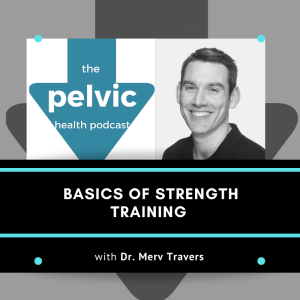
Thursday Jan 09, 2020
Basics of Strength Training with Dr. Merv Travers
Dr. Merv Travers is a Senior Research Scholar working in the area of low back pain, tendon pain and exercise rehabilitation at the School of Physiotherapy, The University of Notre Dame Australia.
In today's episode, Merv discusses what exactly strength training is, why it’s important for all of our bodies and how physiotherapists can get their patients started and progressing. And of course my son, Rylan, had to compete with his sister in podcast recording (and special blooper takes at the end). Check out the reference list below Merv kindly put together for us!
More about Merv...he completed his PhD at Curtin University where he also maintains an Adjunct Research Fellow role. His teaching areas include anatomy and exercise rehabilitation. He has a Masters of Manipulative Therapy and is a qualified strength & conditioning coach (Australian Strength and Conditioning Association – Level 2).
Merv’s clinical background includes working in professional rugby union and he provides clinical consultation for complex musculoskeletal conditions at Star Physio, WA.
Merv guest lectures nationally and internationally on the topics of strength and conditioning for physiotherapists and tendinopathy rehabilitation, as well as runs an international strength conditioning course for physiotherapists.
Optimise Rehab - courses for Strength and Conditioning courses for physios
Some key references pertaining to some of this things we spoke about:
Public Health and strength training:
Steele, J., Fisher, J., Skivington, M., Dunn, C., Arnold, J., Tew, G., . . . Winett, R. (2017). A higher effort-based paradigm in physical activity and exercise for public health: making the case for a greater emphasis on resistance training. BMC Public Health, 17(1), 300.
Dankel, S. J., Loenneke, J. P., & Loprinzi, P. D. (2016). Determining the Importance of Meeting Muscle-Strengthening Activity Guidelines: Is the Behavior or the Outcome of the Behavior (Strength) a More Important Determinant of All-Cause Mortality? Mayo Clin Proc, 91(2), 166-174.
Strain, T., Fitzsimons, C., Kelly, P., & Mutrie, N. (2016). The forgotten guidelines: cross-sectional analysis of participation in muscle strengthening and balance & co-ordination activities by adults and older adults in Scotland. BMC Public Health, 16(1), 1108.
Physio knowledge of guidelines:
Lowe, A., Littlewood, C., McLean, S., & Kilner, K. (2017). Physiotherapy and physical activity: a cross-sectional survey exploring physical activity promotion, knowledge of physical activity guidelines and the physical activity habits of UK physiotherapists. BMJ Open Sport & Exercise Medicine, 3(1)
Lifting with a neutral spine:
Saraceni, N., Kent, P., Ng, L., Campbell, A., Straker, L., & O'Sullivan, P. (2019). To Flex or Not to Flex? Is There a Relationship Between Lumbar Spine Flexion During Lifting and Low Back Pain? A Systematic Review With Meta-Analysis. J Orthop Sports Phys Ther, 1-50
Achilles tendon pain and loading:
Murphy, M., Travers, M., Gibson, W., Chivers, P., Debenham, J., Docking, S., & Rio, E. (2018). Rate of Improvement of Pain and Function in Mid-Portion Achilles Tendinopathy with Loading Protocols: A Systematic Review and Longitudinal Meta-Analysis. Sports Medicine.
Placebo and Exercise:
Crum, A. J., & Langer, E. J. (2007). Mind-set matters: exercise and the placebo effect. Psychol Sci, 18(2), 165-171.
Minimum strength dosage:
Androulakis-Korakakis, P., Fisher, J. P., & Steele, J. (2019). The Minimum Effective Training Dose Required to Increase 1RM Strength in Resistance-Trained Men: A Systematic Review and Meta-Analysis. Sports Medicine.
No comments yet. Be the first to say something!